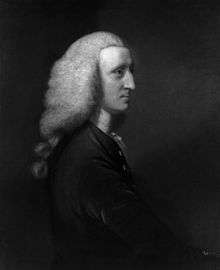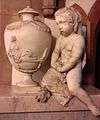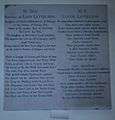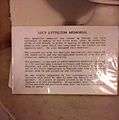George Lyttelton, 1st Baron Lyttelton
| The Right Honourable The Lord Lyttelton PC | |
|---|---|
 | |
| Chancellor of the Exchequer | |
|
In office 25 November 1755 – 16 November 1756 | |
| Monarch | George II |
| Prime Minister | The Duke of Newcastle |
| Preceded by | Hon. Henry Bilson Legge |
| Succeeded by | Hon. Henry Bilson Legge |
| Personal details | |
| Born |
17 January 1709 Hagley, Worcestershire |
| Died |
22 August 1773 (aged 64) Hagley, Worcestershire |
| Nationality | British |
| Political party | Whig |
| Spouse(s) |
(1) Lucy Fortescue (d. 1747) (2) Elizabeth Rich |
| Alma mater | Christ Church, Oxford |
George Lyttelton, 1st Baron Lyttelton PC (17 January 1709 – 22 August 1773), known as Sir George Lyttelton, Bt between 1751 and 1756, was a British statesman and patron of the arts from the Lyttelton family.
Background and education
Lord Lyttelton was the son of Sir Thomas Lyttelton, 4th Baronet, by his wife Christian, daughter of Sir Richard Temple, 3rd Baronet. He was educated at Eton and Christ Church, Oxford.
Political career
He was Member of Parliament (MP) for Okehampton from 1735 to 1756. In 1741 he was also elected for Old Sarum, but chose to continue to sit for Okehampton.
He was one of the politicians who opposed Robert Walpole as a member (one of Cobham's Cubs) of the Whig Opposition the 1730s. He served as secretary to Frederick, Prince of Wales, from 1737,[1] and as a Commissioner of the Treasury in 1744. After Walpole's fall, Lyttelton became Chancellor of the Exchequer (1755). In 1756 he was raised to the peerage as Lord Lyttelton, Baron of Frankley in the County of Worcester.
Arts patronage
Lord Lyttelton was a friend and supporter to Alexander Pope in the 1730s and to Henry Fielding in the 1750s. James Thomson addresses him throughout his poem The Seasons, and Lyttelton arranged a pension for Thomson. He wrote Dialogues of the Dead in 1760 with Elizabeth Montagu, leader of the bluestockings, and The History of the Life of Henry the Second (1767–1771). The former work is part of a tradition of such dialogues. Henry Fielding dedicated Tom Jones to him. Lyttelton spent many years and a fortune developing Hagley Hall and its park which contains many follies. The hall itself, which is in north Worcestershire, was designed by Sanderson Miller and is the last of the great Palladian houses to be built in England.
Dialogue with Gilbert West
In the 1740s, Lyttelton and Gilbert West went to Oxford. There, they agreed to research two key points of Christianity, with the aim of proving them false. Lyttelton set out to prove that Saul of Tarsus was never really converted to Christianity, and West intended to demonstrate that Jesus never really rose from the dead. Each planned to do a painstaking job, taking a year to establish his case. But as they proceeded, they eventually concluded that Christianity was true and became Christians.
West eventually wrote "Observations on the History and Evidences of the Resurrection of Jesus Christ". Lyttelton wrote a lengthy text titled "Observations on the Conversion and Apostleship of St. Paul. in a Letter to Gilbert West, Esq." West became convinced of the truth of the Resurrection, and Lyttelton of the genuine conversion of Saint Paul on the basis of it. For example, Lyttelton wrote to West in 1761,
"Sir, in a late conversation we had together upon the subject of the Christian religion, I told you that besides all the proofs of it which may be drawn from the prophecies of the Old Testament, from the necessary connection it has with the whole system of the Jewish religion, from the miracles of Christ, and from the evidence given of his reflection by all the other apostles, I thought the conversion and apostleship of Saint Paul alone, duly considered, was of itself a demonstration sufficient to prove Christianity a divine revelation."[2]
Family
Lord Lyttelton married firstly Lucy, daughter of Hugh Fortescue, in 1742.[3] After her death in 1747 he married secondly Elizabeth, daughter of Field Marshal Sir Robert Rich, 4th Baronet, in 1749. He died in August 1773, aged 64, and was buried in Christ Church Cathedral.[4] He was succeeded by his eldest son from his first marriage, Thomas.
- St John the Baptist Church, Hagley, memorial to George Lyttelton, 1st Baron Lyttelton (1709–1773)
 St John the Baptist Church, Hagley, memorial statue to Lucy Lyttelton (née Fortescue, died 1747), the first wife of George Lyttelton, 1st Baron Lyttelton
St John the Baptist Church, Hagley, memorial statue to Lucy Lyttelton (née Fortescue, died 1747), the first wife of George Lyttelton, 1st Baron Lyttelton St John the Baptist Church, Hagley, memorial inscription to Lucy Lyttelton (née Fortescue, died 1747)
St John the Baptist Church, Hagley, memorial inscription to Lucy Lyttelton (née Fortescue, died 1747) St John the Baptist Church, Hagley, information panel at statue to Lucy Lyttelton (née Fortescue, died 1747)
St John the Baptist Church, Hagley, information panel at statue to Lucy Lyttelton (née Fortescue, died 1747)
Notes
- ↑ Office holders
- ↑ American Antiquarian Society, Early American Imprints, No.8909 (1639-1800 A.D.), p.3
- ↑ Lucy Fortescue biography, access date 3 December 2015
- ↑ Memorial there.
References
- Leigh Rayment's Peerage Pages
- Burkes Peerage and Baronetage (1939), s.v. Cobham, Viscount
External links
| Wikiquote has quotations related to: George Lyttelton, 1st Baron Lyttelton |
- George Lyttelton at the Eighteenth-Century Poetry Archive (ECPA)
- Works by George Lyttelton, 1st Baron Lyttelton at Project Gutenberg
- Works by or about George Lyttelton, 1st Baron Lyttelton at Internet Archive
| Parliament of Great Britain | ||
|---|---|---|
| Preceded by William Northmore Thomas Pitt of Boconnoc |
Member of Parliament for Okehampton 1735 – 1756 With: Thomas Pitt of Boconnoc to 1754 Robert Vyner from 1754 |
Succeeded by Robert Vyner William Pitt (the Elder) |
| Political offices | ||
| Preceded by James Pelham |
Secretary to Frederick, Prince of Wales 1737–1744 |
Succeeded by Henry Drax |
| Preceded by The Earl of Lincoln |
Cofferer of the Household 1754–1756 |
Succeeded by The Duke of Leeds |
| Preceded by Henry Bilson Legge |
Chancellor of the Exchequer 1755–1756 |
Succeeded by Henry Bilson Legge |
| Peerage of Great Britain | ||
| New creation | Baron Lyttelton 1756–1773 |
Succeeded by Thomas Lyttelton |
| Baronetage of England | ||
| Preceded by Thomas Lyttelton |
Baronet (of Frankley) 1751–1773 |
Succeeded by Thomas Lyttelton |
.svg.png)